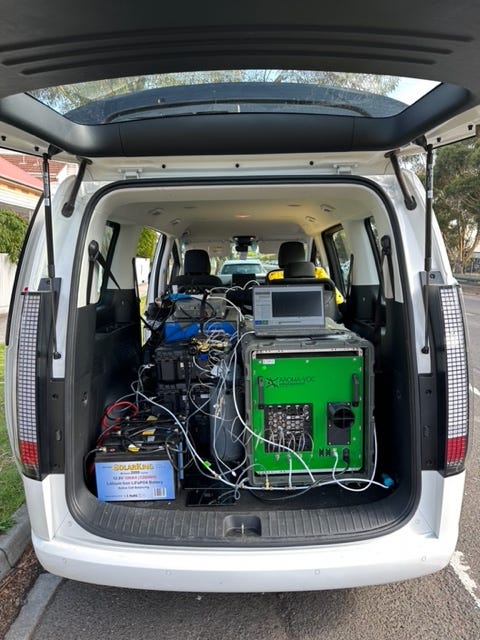
The AROMA-VOC packed into a “mobile lab” for use by Stanford University in investigating indoor air pollution. Credit: Colin Finnegan
Hitting Close to Home: Using AROMA to Measure Emissions from Indoor Stoves
02nd Nov 2023
A Q&A with Dr. Eric Lebel at PSE Healthy Energy
As an undergraduate student at Providence College, Eric Lebel had a unique internship experience: measuring atmospheric gasses from aboard a NASA-operated DC-8 aircraft in California. After that, he was hooked on the idea of using his biochemistry background for earth science applications and would go on to obtain a PhD in Stanford, working on measuring methane emissions. Since then, his work has broadened, using his expertise to measure not only methane but also other gasses from both outdoor and indoor sources.
A senior scientist at PSE Healthy Energy, Lebel has expanded his toolkit for such measurements over time, with AROMA-VOC now part of his arsenal. Recently published work with Yannai Kashtan of Stanford and others using AROMA has shown that natural gas and propane combustion from stoves inside people’s homes raises indoor levels of benzene, a known carcinogen, above well-established health benchmarks. We spoke with Lebel about this work, public perceptions of indoor gas emissions, and next steps for his work with AROMA and beyond.

ET: For your PhD at Stanford, why did you first focus on methane?
Lebel: Methane is a greenhouse gas, 84 times stronger than carbon dioxide pound for pound over a 20-year lifespan. I started off mainly looking at methane emissions from abandoned oil and gas wells and then residential natural gas appliances, which are two areas where the methane emissions were relatively less characterized in California compared to other sources of methane emissions.
ET: How did that then evolve into your current work?
Lebel: When we started measuring gas stoves, we realized that we couldn’t just be measuring methane, that we had to look at other potential pollution because it was being emitted directly into someone’s home; someone is usually standing right there during the operation of the appliance. And there is no guaranteed mechanism to expel all the byproducts of combustion out of the house; an exhaust hood can help, but in many cases it is not 100% efficient, or isn’t even turned on by the user. Therefore, we started to think about other ways we could expand the research into other chemicals, including NOx [nitrogen oxides] emissions and then eventually we learned about the AROMA at Entanglement, which led to our collaboration, enabling new indoor measurements of benzene and other chemicals.
ET: You’ve been an author on two recent papers in Environmental Science and Technology that looked at gas emissions from stoves from over 100 homes, collectively, in California and Colorado. Did anything come out of that study that surprised you?
Lebel: Yes, a few things. When we started measuring the gas appliances, we found there are a lot of emissions during periods when you wouldn’t expect there to be methane emissions, like when they’re off, for example with water heaters. So in a way, it was surprising that we were finding emissions during those times. In another way, it was not surprising because of research on oil and gas infrastructure that has shown how common leaks are in the system. But for the appliances, it was also surprising that it was going undetected in terms of the smell of the gas inside homes.
In general, it is a problem that is literally close to home. It’s not just leaks in some far off distant oil field, it’s inside your home. Being able to uncover that in a systematic way was also surprising.
Lastly, although the NOx we documented from the combustion of gas in stoves was not surprising, as it had been documented in the past, it was the first time that someone had measured the emission rate from inside modern residential stoves, and the first time measuring benzene. To my knowledge, no one’s ever measured benzene directly from residential stoves. We found emissions from gas and propane stoves but much lower emissions from electric ones (and in many cases no detectable emissions at all), which showed that it was the fuel source and not the food being cooked. And that was surprising to everybody on the team.
Oftentimes, people don’t realize the gas stove inside their home is literally burning fossil fuel that’s been piped into their home thousands of miles away.
ET: How did AROMA-VOC enable the benzene measurements?
Lebel: Before AROMA, there was not a good way to show up in someone’s home and measure benzene onsite to this level of precision. Before, we would have had to take samples and ship them off to a lab or bring some really complex GC-MS to a home. But with the AROMA, we can use it directly in the home or, even better yet, leave it in the van parked in the driveway, and just run a hose inside the house. And at the end of the day, we receive data every 15 minutes from the measurements inside the home, to the same level of precision that you’d expect from a GC-MS to part per trillion [ppt] resolution. This is really key for these measurements as the OEHHA 8-hr Reference Exposure Level for benzene is about 1 part per billion.
ET: Were homeowners surprised by what you found?
Lebel: I can speak about general public perceptions I’ve noticed in previous studies on this topic: Oftentimes, people don’t realize the gas stove inside their home is literally burning fossil fuel that’s been piped into their home thousands of miles away. And it’s a similar combustion process going on inside their cars when they are driving around, albeit cleaner. So people have this impression that gas is clean and don’t realize that byproducts of combustion, like NOx, benzene, and carbon monoxide are being emitted directly into their home.
ET: After you collect data, how do you share it with communities?
Lebel: Journal articles are our main main methods of publication. But we have other means, such as through reports and blogs on our website. We talk with journalists, as well as policymakers at the state and federal level. We’ve spoken to legislative organizations, for example, in California about what the data is showing. As scientists, we want to make sure that the people responsible for making public policy are aware of and understand the latest science.
ET: What do you hope to do next with this work?
Lebel: There are a lot of potential research areas for the team at PSE, especially now that we purchased an AROMA-VOC to undertake more indoor and outdoor air quality measurements. One that’s top of mind right now is to take our research into commercial settings. We’ve done a lot of work examining residential appliances so far, but we’re really interested in understanding the risks in commercial kitchens, which employ more than 10 million restaurant workers in the United States. Some chefs prefer to cook with gas but we don’t know the effect that has on workers or restaurant patrons, so we want to design a study to test that.
For more information, please contact us.
